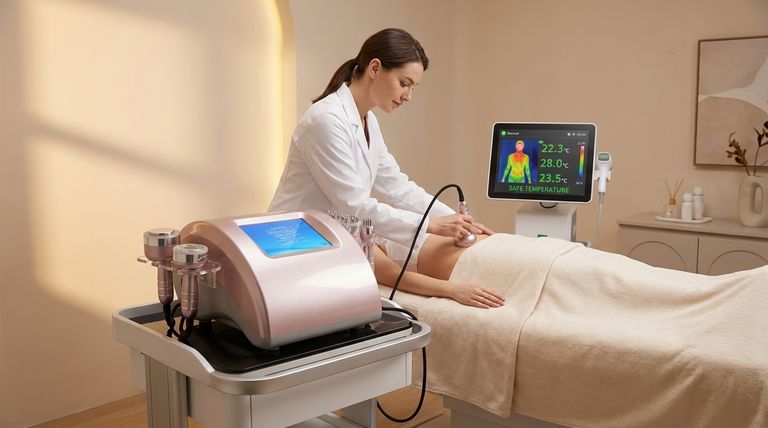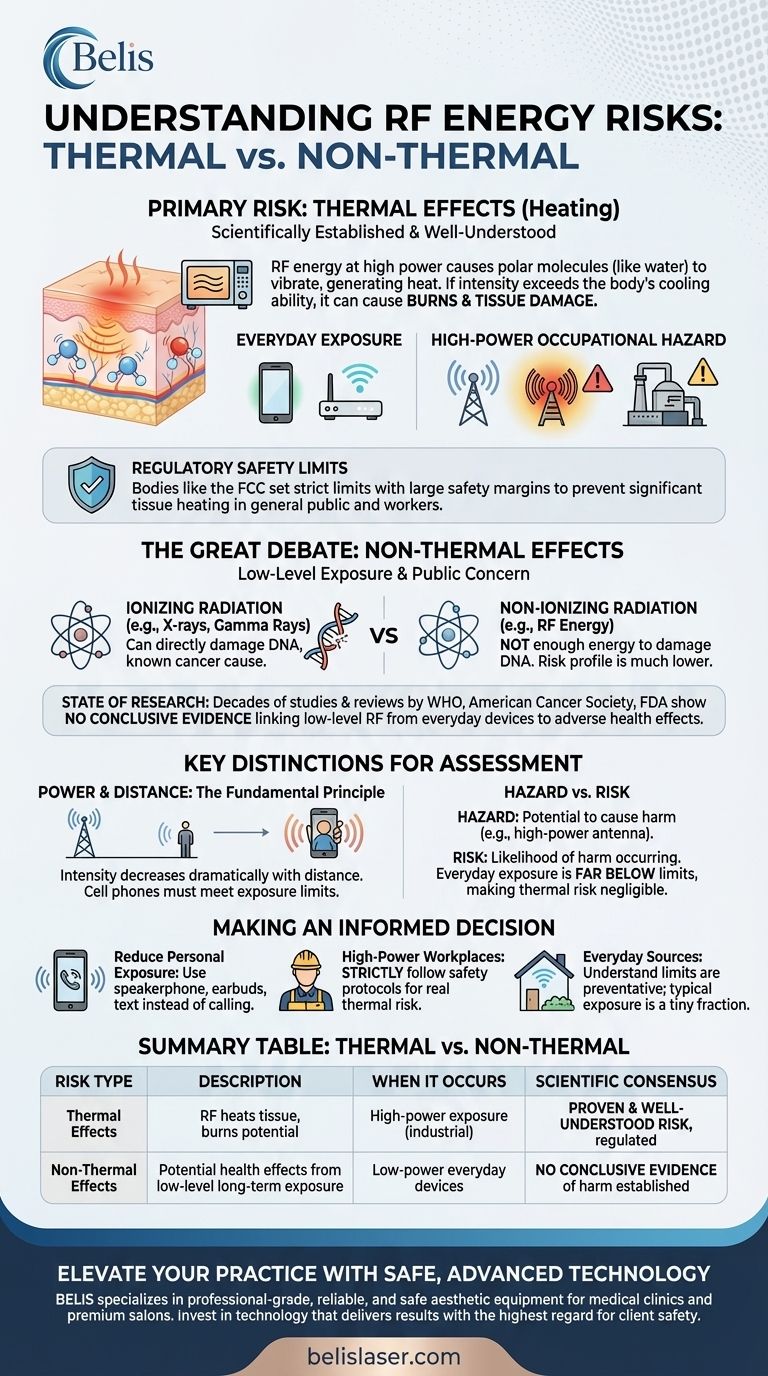The primary, scientifically established risk of radiofrequency (RF) energy is thermal, meaning the heating of biological tissue. This occurs only at very high power levels, where the body cannot dissipate the generated heat, potentially leading to burns and tissue damage. For the vast majority of everyday exposures, these power levels are not reached.
The core issue is one of intensity. While high-power RF poses a clear thermal hazard, the debate surrounding the low-power RF from everyday devices like cell phones and Wi-Fi centers on potential non-thermal effects, for which no definitive health risks have been established.

The Core Risk: Thermal Effects
The most understood and proven risk from RF energy is its ability to generate heat. This is the same principle used by a microwave oven.
How RF Energy Heats Tissue
RF energy causes polar molecules, primarily water, within body tissue to vibrate. This vibration produces heat.
If the intensity of the RF exposure is high enough, it can raise the temperature of the exposed tissue faster than the body's natural cooling mechanisms (like blood flow) can carry the heat away.
When Heating Becomes a Danger
This thermal risk is not a concern with everyday devices. It is a known occupational hazard for individuals working very close to high-power RF sources, such as powerful broadcasting antennas or industrial heating and sealing equipment.
Without proper safety procedures in these environments, the concentrated RF energy can cause severe localized heating, resulting in deep burns and permanent tissue damage.
Regulatory Safety Limits
Because this heating effect is well-documented, regulatory bodies like the Federal Communications Commission (FCC) set strict safety limits for RF exposure.
These limits are designed with a large safety margin to ensure that the general public and workers are not exposed to RF levels anywhere near high enough to cause significant tissue heating.
The Great Debate: Non-Thermal Effects
The more common public concern revolves around potential health effects from long-term, low-level RF exposure that is not strong enough to cause heating.
Ionizing vs. Non-Ionizing Radiation
It is critical to understand that RF energy is a form of non-ionizing radiation. This means it does not have enough energy to knock electrons out of atoms or molecules.
This fundamentally distinguishes it from ionizing radiation, such as X-rays or gamma rays, which can directly damage DNA and are a known cause of cancer. RF energy's inability to cause this type of damage is a key reason its risk profile is considered much lower.
The State of the Research
Decades of extensive research have been conducted on the potential non-thermal effects of RF energy.
Major health and scientific organizations worldwide (including the World Health Organization, American Cancer Society, and U.S. Food and Drug Administration) have reviewed this body of evidence. The overwhelming scientific consensus is that there is no established or conclusive evidence linking low-level RF exposure from devices like cell phones or Wi-Fi to adverse health effects, including cancer.
Understanding the Key Distinctions
To accurately assess RF risk, you must move beyond a simple "is it safe?" question and consider the critical factors of power and distance.
The Critical Role of Power and Distance
The intensity of RF energy decreases dramatically with distance from the source. This is a fundamental principle of physics.
Your exposure from a cell tower hundreds of feet away is orders of magnitude lower than the exposure from a cell phone held directly against your head. Even so, all cell phones sold in the U.S. must be tested to ensure they do not exceed FCC-mandated exposure limits.
Hazard vs. Risk
A hazard is something with the potential to cause harm (e.g., a high-power RF antenna). Risk is the likelihood of that harm actually occurring.
For most people, the exposure levels to RF in daily life are so far below the safety limits that the actual risk of harm from the known thermal hazard is considered negligible.
Making an Informed Decision
Your approach to managing RF exposure should be based on your specific context and level of personal concern.
- If your primary focus is reducing personal exposure from your phone: Simple behavioral changes like using the speakerphone, wired or wireless earbuds, or texting instead of calling will significantly reduce your exposure.
- If you work with high-power RF equipment: You must strictly follow all workplace safety protocols, as the thermal risk in your environment is real and well-understood.
- If your concern is everyday sources like Wi-Fi or cell towers: Understand that regulatory limits are in place to prevent known harm, and typical exposure is a tiny fraction of these conservative limits.
Ultimately, understanding the distinction between the proven thermal risks of high-power RF and the unproven concerns of low-power exposure is the key to navigating the modern world with confidence.
Summary Table:
| Risk Type | Description | When It Occurs | Scientific Consensus |
|---|---|---|---|
| Thermal Effects | RF energy heats tissue, potentially causing burns. | High-power exposure (e.g., industrial equipment). | Proven and well-understood risk. Regulated with safety limits. |
| Non-Thermal Effects | Potential health effects from low-level, long-term exposure. | Low-power exposure from everyday devices (e.g., cell phones, Wi-Fi). | No conclusive evidence of harm established by major health organizations. |
Ready to Elevate Your Practice with Safe, Advanced Technology?
While everyday RF exposure is managed by strict safety standards, the equipment you use in your clinic defines your standard of care and safety. BELIS specializes in providing medical aesthetics clinics and premium beauty salons with professional-grade, reliable, and safe aesthetic equipment.
Let us help you invest in technology that delivers exceptional results with the highest regard for client safety and comfort.
Contact BELIS today to explore our range of professional medical aesthetic equipment and find the perfect solution for your business.
Visual Guide

Related Products
- Ultrasonic Cavitation Radiofrecuency Machine for Body Slimming
- EMS Body Sculpting Slimming Machine EMSlim Body Slimming Machine
- EMSlim Body Sculpting Machine EMS Body Slimming Machine
- EMSlim RG Laser Body Sculpting and Slimming Machine
- Cryolipolysis Fat Freezing Machine Ultrasonic Cavitation Fat Reducing Device
People Also Ask
- Where does fat go after cavitation? Understand the Journey from Cell to Elimination
- What are the restrictions for cavitation? Ensure Your Safety and Treatment Success
- Does cavitation destroy fat cells permanently? Yes, for targeted, stubborn fat reduction.
- When should you not use a cavitation machine? Critical Safety Guidelines for Aesthetic Treatments
- What are the negative side effects of cavitation? Understanding the Risks for Your Practice



















